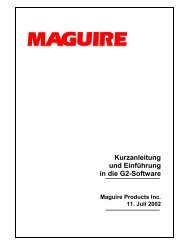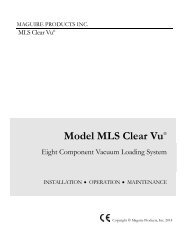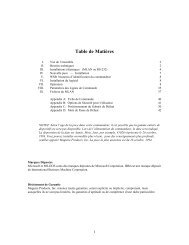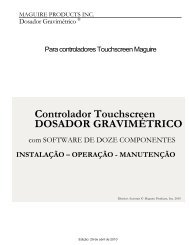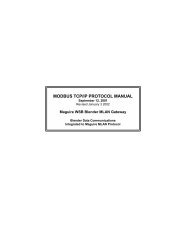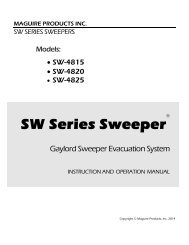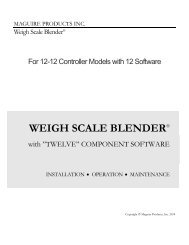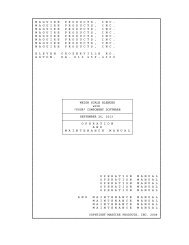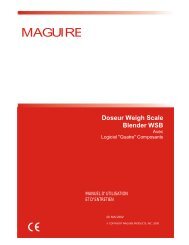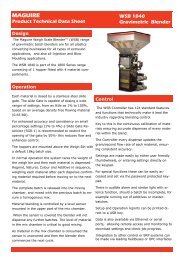WEIGH SCALE BLENDER® - Maguire Products
WEIGH SCALE BLENDER® - Maguire Products
WEIGH SCALE BLENDER® - Maguire Products
You also want an ePaper? Increase the reach of your titles
YUMPU automatically turns print PDFs into web optimized ePapers that Google loves.
<strong>WEIGH</strong> <strong>SCALE</strong> <strong>BLENDER®</strong><br />
MAGUIRE PRODUCTS, INC.<br />
indicating the totals have been collected for this cycle. If the G2F Parameter is on, the<br />
blender will stop running cycles and alarm because the flag had not been set, indicating<br />
the totals had not been collected for the previous cycle. At that time the "Get Status"<br />
MLAN protocol command will return an alarm status of 26.<br />
XMO<br />
Maximum Extruder Output (or MXO)<br />
For Extrusion Control, this parameter stores the extruder throughput rate that can be<br />
expected when control voltage is set to it's maximum output of 10 volts. On start up,<br />
before the unit has time to learn the correct voltage/throughput relationship, this<br />
parameter is used as a starting point. Having this value allows the customer to switch to<br />
Throughput mode right away; no need to wait several cycles. XMO is adjusted and<br />
corrected frequently by the software to match your process. The only time it is zero is on<br />
the very first start up of the system. XMO is the rate in pounds per hour, or kilos per hour.<br />
LTP<br />
Loss In Weight Trip Point<br />
For Extrusion Control, Yield Control, when a Loss In Weight station is part of the system,<br />
an adjustment "trip point" must be specified. This is the total accumulated error that is<br />
required to cause an adjustment to the learned rate. This is the equivalent to the XTP<br />
parameter, which is explained earlier. The last 3 digits are a percentage in tenths (xx.x) of<br />
the total batch that is being monitored. If the system is filling the Loss In Weight bin to a<br />
total weight of 10,00 grams, for example, and allowing it to drop to 4000 grams, for<br />
example, before refilling, then the batch is 6000 grams. If LTP is set to 00010, then this is<br />
1 percent of 6000, or 60 gram trip point. See XTP for more explanation of trip point.<br />
LLF<br />
Loss In Weight Low Level Fill<br />
Value in grams that will cause the fill valve on the Loss In Weight system to open and<br />
begin to fill. This parameter is set automatically by the *22 LIW Model Selection.<br />
HLF<br />
Loss In Weight High Level Fill<br />
Value in grams that will cause the fill valve on the Loss In Weight system to close and<br />
stop the fill process. This parameter is set automatically by the *22 LIW Model Selection.<br />
RLO<br />
LT1<br />
LT2<br />
Lowest Dump Rate (Grams/Second)<br />
Lower SETTING limit for REGRIND (0xxx.x).<br />
_SE parameters SET UPPER LIMITS to the thumbwheels. For color and additive, lower<br />
settings may help ensure expensive material is not wasted.<br />
RLO sets a LOW limit of 5 percent to the REGRIND setting.<br />
Loader Timeout #1<br />
Loader Timeout #2<br />
LT1 and LT2 (set ONLY if your controller is modified to control a loader)<br />
The LT1 and LT2 parameters are normally set to all zeros, indicating that this feature is<br />
not present on your system.<br />
If you have additional outputs on your WSB controller for driving a loading system, then<br />
this parameter should be set to some number indicating how many seconds you will<br />
attempt to load before sounding the ALARM. A sensor input to the controller tells the<br />
loader to load. When the sensor is covered the loader stops. If the sensor is not covered<br />
within the specified number of seconds, the strobe light and the beeper are activated and<br />
Edition: March 24, 2008 67



